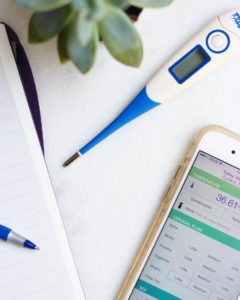Tracking your menstrual cycle can provide more information than an estimation of when your next period is. It can provide insight into your hormonal health and reproductive health and give you more clarity as to when you are more fertile, which can help to both avoid and achieve pregnancy, depending on what your goals are. By doing so, we are better able to understand the days of the month that we are most fertile, and can then either try to conceive around that time or avoid unprotected sex during that window. The average menstrual cycle is around 28-32 days with day 1 of a cycle being the first day of menses and ovulation often occurring around day 14, but this can vary depending on the individual. The first half of our cycle is known as the follicular phase, in which the follicles in the ovary mature. From ovulation to the first day of menses is known as the luteal phase, in which the lining of the uterus thickens and prepares for pregnancy. There is a window when pregnancy may be possible, which often includes five days before ovulation, the day of ovulation and 1-2 days afterwards. In clinical guidelines this occurs between days 10 and 17, however only 30% of women fall within this range so the timing of this window is very unpredictable and often occurs earlier or later than these guidelines suggest. Since the length of a typical cycle can vary, and not everyone has 28 day cycles it can be useful to keep track of your cycles for a few months so you know when your window is and can become more aware of your hormonal and reproductive health. Below are a few tools that can be used to track your cycles: 
Basal Body Temperature (BBT) – your body temperature rises very slightly just after ovulation until the beginning of your period. This rise is due to the hormone progesterone, which is required to maintain pregnancy and nurture a fertilized egg. If the released egg is not fertilized, the lining of your uterus will be shed around 12-16 days after the temperature rise. By recording your temperature every morning you can track these changes and gain more understanding as to when ovulation occurs, which is often one or two days before the thermal shift. Sometimes this rise is less than a degree so we recommend using tools that can help you visualize this change. Kindara, Clue and Glow are apps for your phone that allows you to enter your temperature each morning and creates a graph for you to visualize the changes throughout each phase. You can also enter cervical fluid consistency, information about intercourse and additional notes that may be useful for you.
How to track BBT: It is important to do this first thing in the morning before you have even gotten out of bed, and it is recommended to record around the same time each morning. This way you can get an accurate reading, without any interference from an increased metabolism during activity. We recommend keeping your thermometer on your nightstand, along with a pen and notepad or your cellphone (on airplane mode at night ;)) to track right afterwards. You are more fertile 2-3 days before ovulation (temperature rise), and for 1-2 days afterwards so if your BBT has spiked for over 3 days your chances of getting pregnant become reduced. Keep in mind that fever, alcohol and receiving less than 3 hours of sleep will affect your temperature reading.
Cervical Mucous – the hormones that control your menstrual cycle also affect the consistency, color and amount of cervical mucous present. This mucous is very important in fertility as it protects the sperm from the acidic environment of the vagina and assists in the movement through the female reproductive tract. Estrogen stimulates the production of cervical fluid, so as these levels fluctuate you may notice changes that can be used to predict more fertile days of your cycle. You can keep track of this by writing it down or by using an app such as the ones mentioned above. A few days before ovulation, estrogen levels increase and the cervical mucous is often sticky and cloudy and then during ovulation it becomes slippery and watery, almost like egg whites. This is the stage when you are most likely to get pregnant as it is the most protective for the sperm. After ovulation, the consistency becomes thicker and mucous production begins to decline, therefore decreasing the chances of conceiving. Insufficient production of fertile quality mucous may be affected by factors such as diet, lifestyle and medications. Talk to your Naturopathic Doctor if you are concerned with the quality or production of your cervical fluid.
Menses – tracking the days that you are on your period is important to gain more understanding of how long your cycles are, how regular they are and become more in tune with certain symptoms that may arise before or after this time. It is a good idea to track your cycle on paper or in an app because it allows you to go back and count the days so you know where you are in your cycle, or if you are late in your cycle you can figure out how many days ago your period would normally have begun. It is also important to track factors such as heavy or light bleeding, any clots or fatigue as these symptoms may coincide with one another. Also track your mood, acne breakouts headaches or migraines to better understand hormonal relationships.
It is also important to track factors such as heavy or light bleeding, any clots or fatigue as these symptoms may coincide with one another. Also track your mood, acne breakouts headaches or migraines to better understand hormonal relationships.
Listen to Your Body – some women can actually feel when they ovulate, a sign known as Mittelschmerz, which comes from the German words “middle” and “pain” indicating pain in the pelvic region in the middle of our cycle (around day 14). This is generally felt on one side of the abdomen, as it is a result of the release of an egg from one ovary. If you notice any changes at any particular time of your cycle, take note and observe for subsequent cycles to confirm if it is a recurrent symptom.These tools are a great start to become more in tune with your body and understand your cycle. If you are seeking additional support in the area of women’s health please book an appointment with one of our Naturopathic Doctors for an individualized treatment plan.
